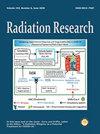比较雌雄 C57BL6 小鼠暴露于辐射的新型蛋白质组表达谱。
摘要
需要为未来涉及辐射照射的大规模伤亡事件提供护理点诊断。需要开发用于生物模拟的辐射照射和剂量预测算法,以便在这些情况下对大量人群进行筛查,还需要探索性别、年龄、遗传异质性和生理合并症可能对生物模拟诊断的实用性产生的潜在影响。在目前的研究中,蛋白质组分析被用来研究年龄匹配的 C57BL6 小鼠在辐照后血液蛋白质组的性别差异,以及使用雄性和雌性样本开发和应用生物剂量学算法的实用性。9-11周大的雌雄小鼠接受了2、4或8Gy剂量的全身辐照(TBI),并在辐照后第1、3和7天收集血浆。然后使用 SomaScan v4.1 分析法对血浆中的 7,000 ∼ 种蛋白质分析物进行筛选。一组蛋白质生物标志物在辐照后的表达发生了显著变化(FDR < 0.05 和 |logFC| > 0.2)。所有蛋白质都被用于特征选择,以利用不同样本和特定性别队列建立辐照预测模型。二元(预测任何辐照)和多剂量(预测特定辐照剂量)模型系列都是利用女性和男性样本组合或仅女性或仅男性样本建立的。二元系列(模型 1、2 和 3)和多剂量系列(模型 4、5 和 6)分别包括女性/男性组合、仅女性和仅男性。在所有样本中,SomaScan 检测法中包含的所有 ∼7,000 个蛋白质都能检测到。使用独特的样本群建立的每种模型算法都经过了样本训练集的验证,并使用单独的新样本系列进行了测试。在模型训练水平上,二元模型系列的总体预测准确率为 100%,用新鲜样本进行测试时,模型 1(女性和男性)的预测准确率为 97.9%,模型 2(仅女性)和模型 3(仅男性)的预测准确率为 100%。当用异性测试特定性别模型 2 和模型 3 时,模型 2 的总体预测准确率下降到 62.5%,模型 3 则保持 100%。在模型训练水平上,多剂量模型系列中所有模型的总体预测准确率均为 100%,而用新鲜样本进行测试时,多剂量模型 4-6 的预测准确率分别为 83.3%、75% 和 83.3%。当使用异性测试特定性别模型 5(仅女性)和模型 6(仅男性)时,总体预测准确率分别降至 52.1%和 68.8%。这些模型代表了辐射反应蛋白组生物标志物的新型预测面板,说明了在开发辐射生物模拟预测算法时考虑性别差异的实用性和必要性。由于在本研究中观察到了性别差异,而且在未来的大规模伤亡环境中使用护理点辐射诊断时必然会包括男女两性,因此考虑性别差异对于确保这些诊断工具在该领域的实用性至关重要。There is a need for point-of-care diagnostics for future mass casualty events involving radiation exposure. The development of radiation exposure and dose prediction algorithms for biodosimetry is needed for screening of large populations during these scenarios, and exploration of the potential effects which sex, age, genetic heterogeneity, and physiological comorbidities may have on the utility of biodosimetry diagnostics is needed. In the current study, proteomic profiling was used to examine sex-specific differences in age-matched C57BL6 mice on the blood proteome after radiation exposure, and the usefulness of development and application of biodosimetry algorithms using both male and female samples. Male and female mice between 9-11 weeks of age received a dose of total-body irradiation (TBI) of either 2, 4 or 8 Gy and plasma was collected at days 1, 3 and 7 postirradiation. Plasma was then screened using the SomaScan v4.1 assay for ∼7,000 protein analytes. A subset panel of protein biomarkers demonstrated significant (FDR < 0.05 and |logFC| > 0.2) changes in expression after radiation exposure. All proteins were used for feature selection to build predictive models of radiation exposure using different sample and sex-specific cohorts. Both binary (prediction of any radiation exposure) and multidose (prediction of specific radiation dose) model series were developed using either female and male samples combined or only female or only male samples. The binary series (models 1, 2 and 3) and multidose series (models 4, 5 and 6) included female/male combined, female only and male only respectively. Detectable values were obtained for all ∼7,000 proteins included in the SomaScan assay for all samples. Each model algorithm built using a unique sample cohort was validated with a training set of samples and tested with a separate new sample series. Overall predictive accuracies in the binary model series was ∼100% at the model training level, and when tested with fresh samples, 97.9% for model 1 (female and male) and 100% for model 2 (female only) and model 3 (male only). When sex-specific models 2 and 3 were tested with the opposite sex, the overall predictive accuracy rate dropped to 62.5% for model 2 and remained 100% for model 3. The overall predictive accuracy rate in the multidose model series was 100% for all models at the model training level and, when tested with fresh samples, 83.3%, 75% and 83.3% for Multidose models 4-6, respectively. When sex-specific model 5 (female only) and model 6 (male only) were tested with the opposite sex, the overall predictive accuracy rate dropped to 52.1% and 68.8%, respectively. These models represent novel predictive panels of radiation-responsive proteomic biomarkers and illustrate the utility and necessity of considering sex-specific differences in development of radiation biodosimetry prediction algorithms. As sex-specific differences were observed in this study, and as use of point-of-care radiation diagnostics in future mass casualty settings will necessarily include persons of both sexes, consideration of sex-specific variation is essential to ensure these diagnostic tools have practical utility in the field.

 求助内容:
求助内容: 应助结果提醒方式:
应助结果提醒方式:


